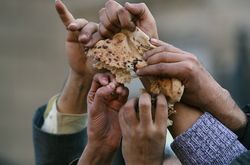by Misha Lepetic
Like ants scurrying for work, for food, and most of all for land.
~ John Steinbeck, “The Grapes of Wrath”
 Received wisdom relies on simple categories to survive and persist. In this sense, certain numbers are repeated until they are virtually canonical. If we could come up with a taxonomy of success for statistics, we might consider the convenience of numbers that freeze flows of population, money or goods into easily retained averages, devoid of the nuances of space or time. I may, for example, agree with the statement that “500 people arrive in Mumbai every day” if whoever responsible for this statement could point me to the set from which this average was derived – was this from 2000 to 2008? Or maybe it was from 1997 to 2011? Let’s consider other aspects that the datum is implying: Are these people migrants who are truly moving to the city, or are they on a long, seasonal loop that takes them back to their villages, or, even more inconveniently, other cities? And could someone please tell me where the city of Mumbai begins (or ends)? Inconvenient truths are both temporal and geographical, but when we are attempting to impress our audience we tend not to speak in graphs but in talking points. This is the peril of a successful statistic.
Received wisdom relies on simple categories to survive and persist. In this sense, certain numbers are repeated until they are virtually canonical. If we could come up with a taxonomy of success for statistics, we might consider the convenience of numbers that freeze flows of population, money or goods into easily retained averages, devoid of the nuances of space or time. I may, for example, agree with the statement that “500 people arrive in Mumbai every day” if whoever responsible for this statement could point me to the set from which this average was derived – was this from 2000 to 2008? Or maybe it was from 1997 to 2011? Let’s consider other aspects that the datum is implying: Are these people migrants who are truly moving to the city, or are they on a long, seasonal loop that takes them back to their villages, or, even more inconveniently, other cities? And could someone please tell me where the city of Mumbai begins (or ends)? Inconvenient truths are both temporal and geographical, but when we are attempting to impress our audience we tend not to speak in graphs but in talking points. This is the peril of a successful statistic.
By the same token, “255 people born every minute” is a nice, smooth number, and not difficult to remember for those uncomfortable moments when the cocktail party conversation needs a nudge. The lazy acceptance of such a statement demonstrates our contentedness with the notion that this is something that is happening consistently, not unlike the comfort we get from looking at a flowing stream: every time we go back to the stream, there it is, still flowing. In a Heraclitean sense, if I dip my toe into that stream of newborns today, they will certainly be different than yesterday’s stream, but it will still be 255. This is comforting. Until, of course, it becomes 256, or 325. But we will have to wait to be told that, too.
Was the seven-billionth person born in Manila on October 31st, 2011? Absolutely – if you are the parents of Danica May Camacho. Declared so by the United Nations, the organization did her the further favour of swooping down on her delivery room, scholarships in hand for the lucky newborn, like an international development version of Publishers Clearinghouse Sweepstakes. (Danica’s parents may want to take heed of the experience of Adnan Nević, the title-holder of Six-Billionth Person of this particular celebrity circuit, whose cradling by Kofi Annan at his birth hasn’t exactly led to a silver spoon in his mouth). But for those paying attention to the vagaries of demographic estimation,
Even the best individual government censuses have a margin of error of at least 1 percent, said [Gerhard Heilig, chief of the population estimates and projections section of the United Nations Population Division], which would translate in the global aggregation to “a window of uncertainty of six months before or six months after Oct. 31.” An error margin of even as little as 2 percent would mean that Monday’s estimate of seven billion actually was 56 million off (which is more people than were counted in South Africa).
By the same token, I am wholly prepared to believe the notion that, “as of 2008, 50% of the global population lives in cities,” if the United Nations could only define for me what constitutes a city (or was that fateful moment set to happen in 2005, as reported in 2005?). Is the city defined as its urban core, or does it involve the surrounding metropolitan area? Richard Saul Wurman famously defined Tokyo in (at least) six different ways, including boundaries determined by postal delivery, utility service, administrative districts, or population density, among other measures that, our intuition tells us, ought to line up together somehow, but instead lead to radically different geographic delineations. At least we can agree that Tokyo is a proper city – a mega-city, even. Ought we then define a “city” by the density of its population? In that case, Tokyo ranks only 50th, and Mumbai reigns supreme – at least by some measures. But at what point does a city stop being a city?
Read more »
